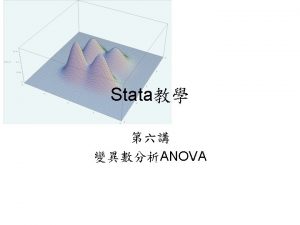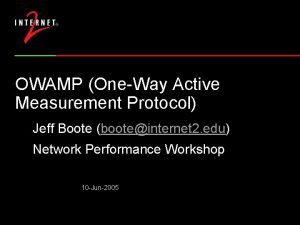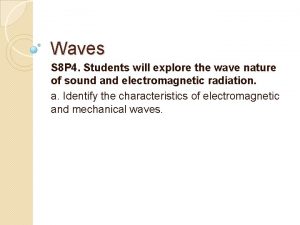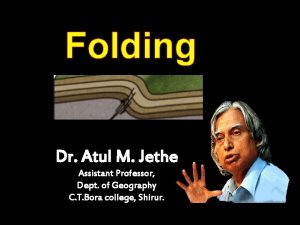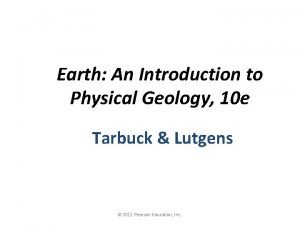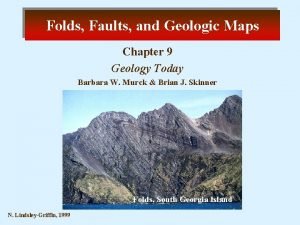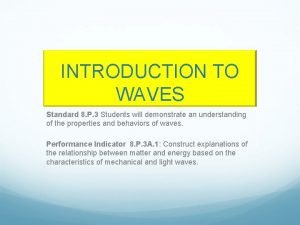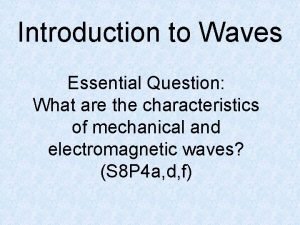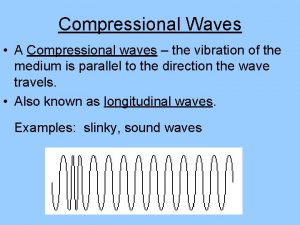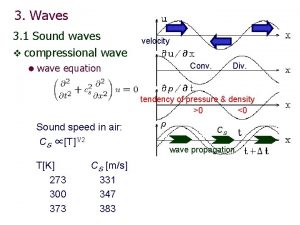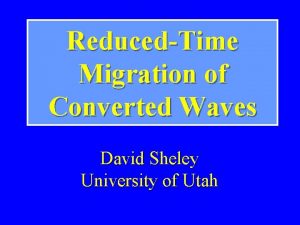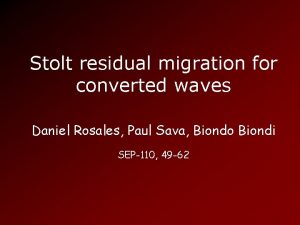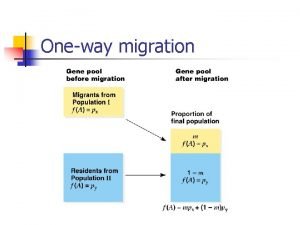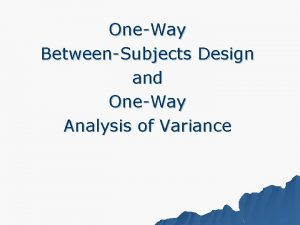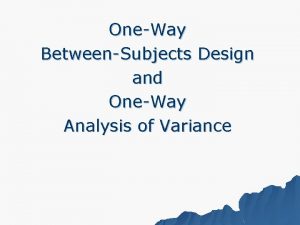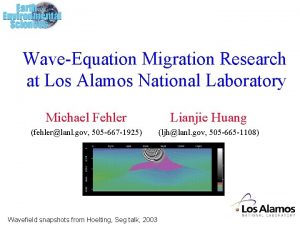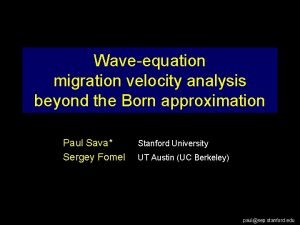Oneway waveequation migration of compressional and converted waves
























- Slides: 24

One-way wave-equation migration of compressional and converted waves in a VTI medium Rose Meeting 2010 Ørjan Pedersen, IPT, NTNU Bjørn Ursin, IPT, NTNU Hans Kristian Helgesen, Statoil ASA

Contents • Derive phase-slowness expressions for quasi-P and quasi-SV waves in a VTI medium which are used in a one-way wave-equation migration scheme. • Numerical examples – demonstrate that the slowness approximations are valid for wideangle propagation – the resulting one-way propagators are validated on a series of synthetic tests and applied on a field ocean-bottom seismic dataset. • The results show that the method accurately images both compressional and converted waves in OBS data over a vertically transverse isotropic medium.

Wave characteristics • The characteristics of wave-propagation can be described by the dispersion relation, relating the vertical (q) and horizontal phaseslowness (p). • It can be found by combining the stiffness coefficients for a VTI medium with the Christoffel-equation. • In a VTI medium

Main imaging methods

One-way wavefield extrapolation • Given a wavefield at depth z. • Dividing the medium into depth-slabs of thickness Δz, the solution of the one-way wave-equation gives: (1) • Extrapolating the wavefield using (1) is expensive. • Various approximative methods exists – Generalized Screen, Beamlets, Fourier finite-difference(FFD), etc. – Here, we focus on the FFD approach. • FFD provide good accuracy vs. efficiency.

One-way wave field extrapolation • For the FFD propagators, the propagator is separated into a phase-shift propagator in a constant background medium and a spatial finite-difference correction accounting for the varying model components. • For the medium perturbations, we need to decouple the spatial and slowness components. • Represent the phase-slowness as: Phase-shift Finite-difference term

Phase-slowness approximations Exact expression: Series representation of square root (similar for ) yield: We approximate the square-root by (Truncated series, j=2) (Continuous fraction)

Accuracy of approximated slowness • Medium parameters: α 0=2000 m/s β 0=1000 m/s δ 0=0. 05, ε 0=0. 10 • Quantify accuracy of slowness approximations by looking at the corresponding relative error in group velocity (group angle). • Less than 1% error: – q. P/q. SV ~ 60°

Accuracy of approximate slowness • Medium parameters: α 0=2000 m/s, β 0=1000 m/s δ 0=0. 15, ε 0=0. 10 • Less than 1% error: – q. P ~ 70° – q. SV ~ 40°

One-way wave field extrapolation

Ocean bottom seismic experiment

Ocean bottom seismic imaging Wave field extrapolation: Imaging condition: k common shot/receiver

Impulse response tests C-wave impulse The impulse response test involves migrating a single input seismic trace in a given medium. The input trace contains a single spike located at time 2. 0 s P-wave impulse • Medium parameters: • By inspection, C-wave accurate up to about 50º, P-wave accurate up to about 70º For larger angles the error introduced by the medium perturbations cause the impulse response to be mis-positioned (inaccuracy of the q. SV slowness approximation for large angles) •

Impulse response tests C-wave impulse The impulse response test involves migrating a single input seismic trace in a given medium. The input trace contains a single spike located at time 2. 0 s P-wave impulse • Medium parameters: • By inspection, C-wave accurate up to about 45º, P-wave accurate up to about 70º In general, the accuracy of the derived one-way propagators for high dips depends on the variation of the medium properties. •

2 D Synthetic data example • We test the ability of the derived migration scheme to handle a subsurface with a relative high degree of medium perturbations. • The model consists of 5 reflecting interfaces the response from the sea-floor is not modelled. • The receivers are placed at the sea-floor and the sources at the sea-surface.

2 D Synthetic data example • A synthetic common-shot dataset was produced using a Born-Kirchhoff -Helmholtz modelling scheme (Ursin and Tygel, 1997) both for P−P and P−S waves.

2 D Synthetic data example • A synthetic common-shot dataset was produced using a Born-Kirchhoff -Helmholtz modelling scheme (Ursin and Tygel, 1997) both for P−P and P−S waves. • After imaging, we see that both the C -wave and pressure-wave migration provide accurate results. The difference between the migrated sections is not very distinct, and the reflector interpretation would most likely coincide for both sections. • Notice that the migrated P−S image has higher resolution than the migrated P−P image since the Swave velocities are slower than the P -wave velocities.

3 D Field data example - Volve • We apply the derived one-way propagators on a 3 D field OBS dataset. The OBS dataset was acquired in 2002 in the central North Sea over the Volve field. The field is located in the Sleipner area in the southern part of the Viking Graben. Image from www. statoil. com

3 D Field data example - Volve • We apply the derived one-way propagators on a 3 D field OBS dataset. The OBS dataset was acquired in 2002 in the central North Sea over the Volve field. The field is located in the Sleipner area in the southern part of the Viking Graben.

3 D Field data example - Volve • • In general, the migrated images P−P and P−S show good structural focusing. The two images correlate well in depth. We notice that the migrated P−P image show better reflector continuity in the deeper part than the migrated P−S image and thereby seems to be better focused. Some differences are found between the distinction of some of the reflectors in the deeper part below about 3 km. These differences are most probably due to differences in the reflectivity for the converted waves.

3 D Field data example - Volve • • In general, the migrated images P−P and P−S show good structural focusing. The two images correlate well in depth. We notice that the migrated P−P image show better reflector continuity in the deeper part than the migrated P−S image and thereby seems to be better focused. Some differences are found between the distinction of some of the reflectors in the deeper part below about 3 km. These differences are most probably due to differences in the reflectivity for the converted waves.

3 D Field data example - Volve

Conclusions • • • We have developed a pre-stack migration scheme for compressional and converted waves using one-way propagators. The method builds on an FFD depth extrapolation scheme for which we derive approximations of the vertical q. P and q. SV slowness as a function of horizontal slowness p. By analysing the corresponding group-velocity as a function of group angle, we show that the approximations are accurate for high angles using small anisotropy parameters and weak non-hyperbolicity. Impulse responses demonstrate the propagator accuracy through good dip response and accurate kinematic behaviour for weak anisotropy. For higher values of the nonhyperbolicity parameter, the accuracy of the compressional propagators are still valid for high angles of propagation, while the C-wave propagators become more inaccurate. The 2 D synthetic data example illustrates the methods ability to handle models with a realistic degree of laterally varying medium parameters. The data example also shows consistency between the compressional and C-wave images. The 3 D field data example shows that the method is applicable to real data. Even thought the compressional and C-wave images show differences in focusing and structural definitions, we also see good correlation in depth in the images.

Acknowledgement • This research was supported by the Norwegian Research Council via the ROSE project. • We would like to thank Statoil ASA for permission to publish and providing the field dataset. • ØP would like to thank Joachim Mispel for help preparing the field data. • Bjørn Ursin has received financial support from Statoil ASA through the VISTA project.
 Stata oneway
Stata oneway Owping
Owping Oneway hash
Oneway hash Whats a compressional wave
Whats a compressional wave Isoclinal fold
Isoclinal fold Compressional mountains
Compressional mountains Osn
Osn Parts of the wave
Parts of the wave Parts of a wavelength
Parts of a wavelength Compare and contrast p waves and s waves using venn diagram
Compare and contrast p waves and s waves using venn diagram Mechanical waves examples
Mechanical waves examples What are the mechanical waves
What are the mechanical waves Differences between mechanical and electromagnetic waves
Differences between mechanical and electromagnetic waves Carbon dioxide temperature
Carbon dioxide temperature Mechanical waves and electromagnetic waves similarities
Mechanical waves and electromagnetic waves similarities Mechanical and electromagnetic waves similarities
Mechanical and electromagnetic waves similarities Surface waves and body waves
Surface waves and body waves Mechanical wave and electromagnetic wave
Mechanical wave and electromagnetic wave Difference between constructive and destructive waves
Difference between constructive and destructive waves What is data converted into a meaningful and useful context
What is data converted into a meaningful and useful context Light and sound travel in waves true or false
Light and sound travel in waves true or false Characteristics of a longitudinal wave
Characteristics of a longitudinal wave Whats a reflected sound wave
Whats a reflected sound wave Electromagnetic waves vs mechanical waves
Electromagnetic waves vs mechanical waves Is a seismic wave mechanical or electromagnetic
Is a seismic wave mechanical or electromagnetic
